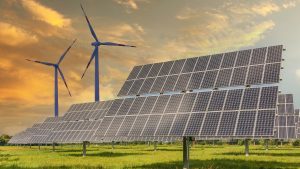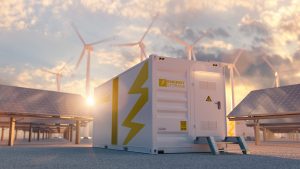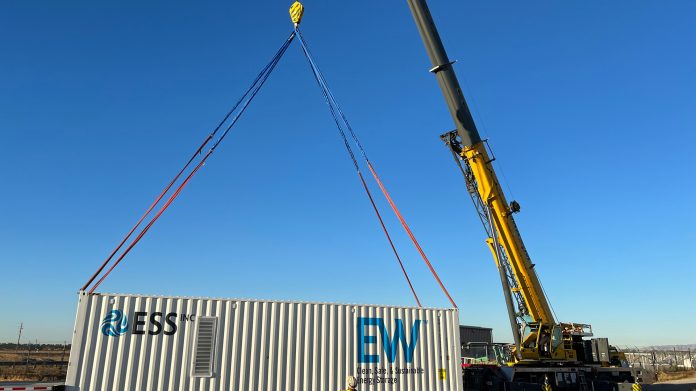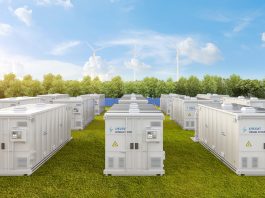Alan Greenshields, Director of Europe at ESS Inc., discusses the importance of energy storage as a renewable energy resource and how this can aid decarbonisation goals.
As the global electricity demand continues to rise and the impacts of climate change become impossible to ignore, nations are striving to meet current and future energy demand with renewable energy resources.
However, as renewable generation increases, it is clear that new technologies and innovation will be required to adapt a grid designed for large, central fossil-fired power stations to intermittent wind and solar power.
One such class of new technology will be grid-scale energy storage, which will play a pivotal role in harnessing the potential of renewable energy sources and ensuring the availability of clean energy when needed.
More power, cleaner power
Electricity currently accounts for about 20% of the world’s total final energy consumption. However, as access to electricity expands and trends towards full electrification of buildings and transportation accelerate, the electricity demand is forecast to grow significantly.
The International Energy Agency estimates that global electricity demand will grow 23-30% between 2022 and 2030 and 75% – 150% by 2050.
The good news is that based on current trends, the IEA predicts that renewable energy resources will dominate the global capacity additions required, accounting for 75-80% of all new capacity by 2050.
In addition to the apparent need to decarbonise energy systems to address climate change, recent geopolitical events have underscored the need for energy security. Fossil fuels, with limited supply chains sometimes reliant upon geopolitically unreliable regions, pose a specific energy security threat.
The revolution of renewable energy resources
Renewable resources are not a distant future technology; wind and solar generation already meet a significant share of current energy demand.

In the UK, 24.5% of electricity was generated by wind turbines in 2022, enough to power 22.8 million homes. The momentum is set to continue with the newly operational Dogger Bank offshore wind farm, capable of powering up to 6 million homes annually.
While concerns about climate change have driven substantial deployment of renewable resources, climate is no longer the sole driver. The cost of renewable energy has fallen rapidly in recent years; today, solar and wind are the most cost-effective sources of electricity in 96% of global markets.
Gas generation averages around $48 per MWh, with coal generation around $74 per MWh, compared to $46 and $45 for on-shore wind and solar, respectively.
With low costs and increasing climate concerns, renewable energy resources are poised to be the dominant form of new energy generation in the coming years.
However, while these trends provide reason for optimism about meeting climate goals, renewables come with their own challenges. By their very nature, wind and solar energy are intermittent. Put another way, wind and sunshine do not respond in real-time to society’s energy demand.
The importance of energy storage
With growing renewable deployment has come new challenges. As renewable energy resources grow, grid operators have found it increasingly difficult to balance electricity supply and demand. This is because, while wind and solar energy are plentiful, the timing of their availability may not match the demand for energy on the grid.
Fortunately, new energy storage technologies are entering the marketplace capable of storing hours of renewable energy to discharge when needed. At sufficient scale, energy storage will stabilise the grid and bank the energy from renewables to enable the grid to operate on clean energy 24/7.
Energy storage is not a new concept. Pumped hydropower has been used for decades, where water is pumped uphill to a reservoir during periods of excess generation and allowed to flow downhill when needed to generate energy.
More recently, lithium-ion technology, the same battery technology used in your laptop or smartphone, has also been deployed at grid scale. However, both technologies come with drawbacks. Pumped hydro is expensive to build and requires a specific geography to work. Li-ion batteries can work well to store and provide power for two to four hours but are uneconomic at longer durations.
In addition, large-scale li-ion installations are associated with safety hazards from fires and toxic materials.
Even if not a new concept, it is becoming clear that new renewable resources will be required to meet the needs of an increasingly renewable grid fully.
Several concepts are currently under development, using a variety of mechanical, physical and chemical processes to store energy for longer periods. The principal challenge is achieving low-cost energy storage–with a levelised storage cost driven by several factors, including capital costs, operating costs, efficiency, and usable life.

The real breakthrough has been the invention of new electrochemical technologies that can provide long-duration energy storage (LDES) with low-cost entitlement.
One early leader in this field is iron flow technology, which has the advantage of storing electricity while being based on safe, abundant, and cost-effective materials. Delivering up to 12 hours of energy storage, iron flow systems are already being deployed to meet the grid’s needs, with projects underway in Europe, Australia, and the US.
From coal to clean
LDES technologies are the lynchpin that will enable the transition to a fully renewable grid. By ensuring that renewable energy resources are available when needed, LDES provides the grid with the resilience and reliability previously provided by fossil generators but without carbon emissions.
German energy company Lausitz Energie Verwaltungs Gmbh (LEAG) announced that it will transform a coal-fired power station in Eastern Germany into a renewable energy hub.
The burning of lignite coal, which has historically dominated this region, will be replaced by up to 14 GW of wind and solar generation. Up to 3 GWh of long-duration energy storage and hydrogen will support this to deliver green baseload power.
The facility will include a 50 MW / 500 MWh iron flow battery system from ESS Inc., which will be commissioned in 2027. ESS’ batteries will bolster the energy hub’s capacity to consistently deliver clean energy, ensuring its availability at all hours, contributing to cost reduction and providing the foundations to support the 200GW predicted needed by 2030 to decarbonise energy systems according to the European Association for Storage of Energy.
Converting coal to clean energy is happening worldwide. Another example can be found in Australia, where Stanwell Corporation is spearheading a similar initiative, alongside Energy Storage Industries Asia Pacific and ESS Inc., to repurpose a coal-fired power plant into a cutting-edge renewable energy hub. This transformation is supported by a 1 MW / 10 MWh iron flow battery pilot project, which will be succeeded by a 150 MW iron flow battery by the end of the decade.
These clean energy hubs provide a blueprint for how LDES can successfully enable renewable energy resources to phase out fossil fuels and strengthen energy security.
A brighter tomorrow
The electricity demand is rising, and climate-driven disasters are increasingly commonplace. War in Ukraine and the Middle East is affecting energy security. Net-zero targets are looming. While taken together, these factors could be reason for pessimism, but there is tremendous opportunity in the clean energy transition ahead.
The good news is that recent technological advancements have made renewable energy resources the most economically viable form of energy. Countries worldwide are investing heavily to accelerate the transition.
With big investments will come clean energy, economic opportunities, employment and a future powered by clean, secure energy resources.









